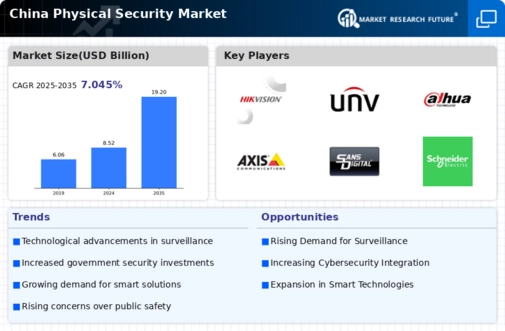The physical security market in China is characterized by a dynamic competitive landscape, driven by rapid technological advancements and increasing demand for integrated security solutions. Key players such as Hikvision (CN), Johnson Controls (US), and Honeywell International (US) are at the forefront, each adopting distinct strategies to enhance their market presence. Hikvision (CN), for instance, focuses heavily on innovation, particularly in AI-driven surveillance technologies, which positions it as a leader in smart security solutions. Meanwhile, Johnson Controls (US) emphasizes regional expansion and partnerships, aiming to integrate its offerings with smart building technologies, thereby enhancing operational efficiency and customer engagement. Honeywell International (US) is also investing in digital transformation, leveraging IoT capabilities to provide comprehensive security solutions that cater to diverse customer needs. Collectively, these strategies contribute to a competitive environment that is increasingly centered around technological innovation and customer-centric solutions.
In terms of business tactics, companies are localizing manufacturing to reduce costs and improve supply chain efficiency. This approach not only enhances responsiveness to market demands but also aligns with government initiatives promoting domestic production. The market structure appears moderately fragmented, with several players vying for market share, yet the influence of major companies remains substantial. The collective actions of these key players shape the competitive dynamics, as they continuously adapt to evolving market conditions and consumer preferences.
In October 2025, Hikvision (CN) announced the launch of its latest AI-powered surveillance system, which integrates advanced analytics and real-time monitoring capabilities. This strategic move is significant as it reinforces Hikvision's commitment to innovation and positions the company to capture a larger share of the growing demand for smart security solutions in urban environments. The introduction of such technology not only enhances security measures but also provides clients with actionable insights, thereby increasing the overall value proposition.
In September 2025, Johnson Controls (US) entered into a strategic partnership with a leading technology firm to develop integrated security solutions that leverage cloud computing and AI. This collaboration is pivotal as it allows Johnson Controls to enhance its product offerings and expand its reach within the smart building sector. By combining expertise, both companies aim to deliver more robust security solutions that meet the evolving needs of customers, particularly in commercial real estate.
In August 2025, Honeywell International (US) unveiled a new suite of cybersecurity solutions designed to protect physical security systems from emerging threats. This initiative underscores the growing recognition of cybersecurity as a critical component of physical security. By addressing vulnerabilities in security infrastructure, Honeywell positions itself as a comprehensive provider of security solutions, catering to the increasing concerns of businesses regarding data protection and system integrity.
As of November 2025, the competitive trends in the physical security market are increasingly defined by digitalization, sustainability, and the integration of AI technologies. Strategic alliances are becoming more prevalent, as companies recognize the need to collaborate to enhance their technological capabilities and market reach. Looking ahead, competitive differentiation is likely to evolve from traditional price-based competition to a focus on innovation, technology integration, and supply chain reliability. This shift suggests that companies that prioritize these aspects will be better positioned to thrive in an increasingly complex and competitive landscape.
















Leave a Comment